《红字》中女主人公个性分析
对《红字》中女主人公的一种荣格式解读
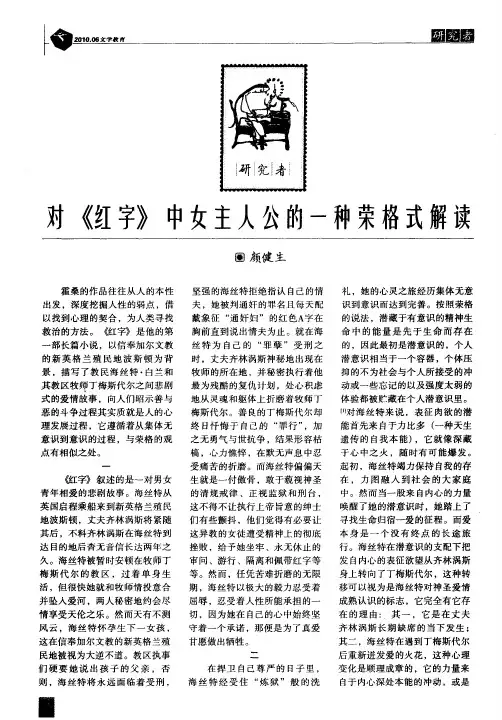
出发 ,深度挖掘人性 的弱点 ,借 以找 到心理的契合 ,为人类 寻找 救治 的方 法。 《 红字》 是 他的第
一
的说 法 ,潜藏于有意识 的精神生
胸 前直到说 出情 夫为止 。就在 海
丝 特 为 自 己 的 “ 孽 ” 受 刑 之 罪
命 中 的能 量 是 先 于生 命 而 存 在
身上转 向了丁梅斯代尔 ,这种转 移可以视为是海 丝特对神圣爱 情
成熟认识 的标 志 ,它完全有 它存 在 的理 由: 其一 ,它 是在 丈 夫 齐 林涡 斯长 期缺 席 的当下 发生
情 享受 天伦之乐 。然 而天有不测
风 云 ,海 丝特 怀孕 生下 一女孩 ,
这在信奉加 尔文教 的新英格 兰殖
的,因此最初是潜意识 的 ,个人 潜意识相 当于一个容器 ,个体 压
部长篇 小说 ,以信奉加 尔文教
的新 英 格 兰 殖 民地 波 斯 顿 为 背
景 ,描写 了教 民海丝 特 ・ 白兰 和 其 教 区 牧 师 丁梅 斯 代 尔 之 间 悲 剧
时 ,丈 夫齐林涡斯神秘 地 出现在
牧 师 的所 在 地 ,并 秘 密 执 行 着 他 最 为 残 酷 的 复 仇 计 划 ,处 心 积 虑
生就是一 付傲骨 ,敢 于藐 视神圣
的清 规 戒 律 、正 视 监 狱 和 刑 台 ,
这不得不让执 行上帝 旨意 的绅 士 们 有些颤抖 ,他们觉得有必要 让 这异教 的女徒 遭受精神上 的彻 底 挫败 ,给予她坐牢 、永 无休止 的 审 问 、游行 、隔离 和佩 带红字等 等 。然而 ,任凭苦难折 磨的无 限 期 ,海 丝 特 以 极 大 的毅 力 忍 受 着 屈辱 ,忍受 着人性所能 承担 的一 切 ,因为 她在 自己的心 中始 终坚 守着一个承诺 ,那便是为 了真爱 甘愿 做出牺牲 。
霍桑的《红字》主要人物性格分析
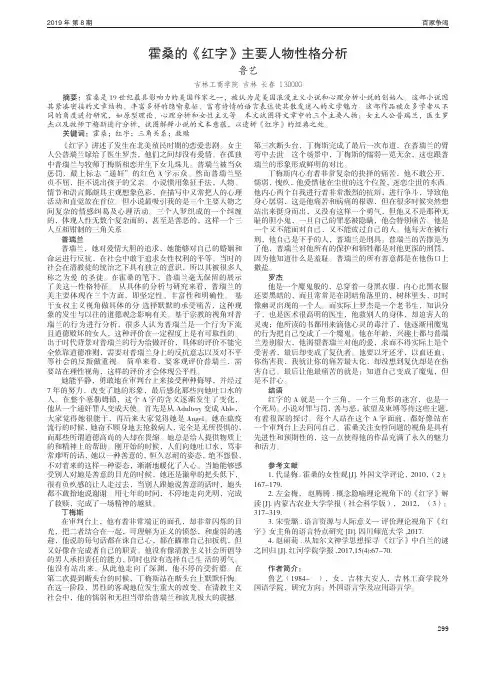
2019年 第8期百家争鸣299霍桑的《红字》主要人物性格分析鲁艺吉林工商学院 吉林 长春 130000《红字》讲述了发生在北美殖民时期的恋爱悲剧。
女主人公普瑞兰嫁给了医生罗杰,他们之间却没有爱情。
在孤独中普瑞兰与牧师丁梅斯相恋并生下女儿珠儿。
普瑞兰被当众惩罚,戴上标志“通奸”的红色A 字示众。
然而普瑞兰坚贞不屈,拒不说出孩子的父亲。
小说惯用象征手法,人物、情节和语言都颇具主观想象色彩,在描写中又常把人的心理活动和直觉放在首位。
但小说最吸引我的是三个主要人物之间复杂的情感纠葛及心理活动。
三个人罗织成的一个纠缠的,体现人性无数个复杂面的,甚至是善恶的,这样一个三人互相钳制的三角关系。
普瑞兰普瑞兰,她对爱情大胆的追求,她能够对自己的婚姻和命运进行反抗,在社会中敢于追求女性权利的平等。
当时的社会在清教徒的统治之下具有独立的意识,所以其被很多人称之为爱 的圣徒。
在霍桑的笔下,普瑞兰毫无保留的展示了美这一性格特征。
从具体的分析与研究来看,普瑞兰的美主要体现在三个方面,即坚定性、丰富性和明确性。
基于女权主义视角做具体的分 选择默默的承受痛苦,这种现象的发生与以往的道德观念影响有关。
基于宗教的视角对普瑞兰的行为进行分析,很多人认为普瑞兰是一个行为下流且道德败坏的女人,这种评价在一定程度上是有可取性的。
出于时代背景对普瑞兰的行为给做评价,具体的评价不能完全依靠道德准则,需要对普瑞兰身上的反抗意志以及对不平等社会的反叛做重视。
简单来看,要客观评价普瑞兰,需要站在理性视角,这样的评价才会体现公平性。
她能平静,勇敢地在审判台上来接受种种侮辱,并经过7年的努力,改变了她的形象,最后感化那些向她吐口水的人。
在整个塞勒姆镇,这个A 字的含义逐渐发生了变化,他从一个通奸罪人变成天使。
首先是从Adultery 变成Able,大家觉得她很能干,再后来大家觉得她是Angel。
她在瘟疫流行的时候,她奋不顾身地去抢救病人,完全是无所畏惧的,而那些所谓道德高尚的人却在畏缩。
浅析《红字》中海丝特·白兰的女性美
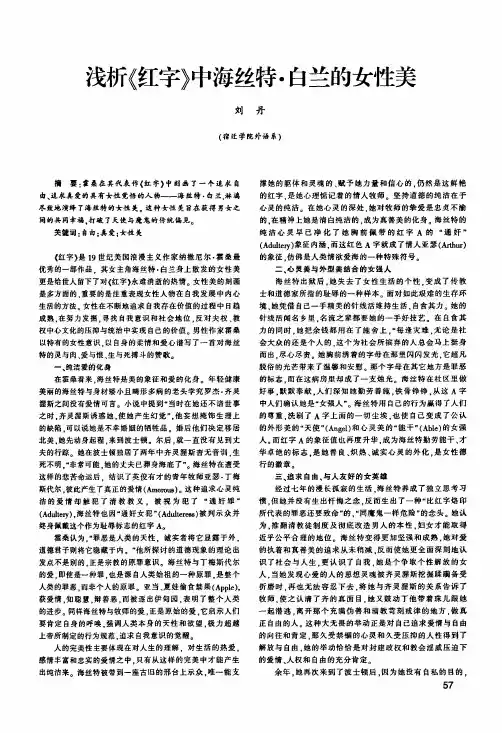
浅析《红字》中海丝特白兰的女性美刘丹(宿迁学院外语系)摘要:霍桑在其代表作《红字)中刻画了一个追求自由、追求真爱的具有女性觉悟的人物——海丝特白兰.淋漓尽致地演绎了海丝特的女性美。
这种女性美旨在获得男女之间的共同幸福,打破了天使与魔鬼的传统偏见。
关键词:自由;真爱;女性美《红字》是19世纪美国浪漫主义作家纳撒尼尔霍桑最优秀的一部作品.其女主角海丝特.白兰身上散发的女性美更是给世人留下了对《红字》永难消逝的热情。
女性美的刻画是多方面的.重要的是注重表现女性人物在自我发展中内心生活的方法。
女性在不断地追求自我存在价值的过程中日趋成熟,在努力发掘,寻找自我意识和社会地位,反对夫权、教权中心文化的压抑与统治中实现自己的价值。
男性作家霍桑以特有的女性意识.以自身的柔情和爱心谱写了一首对海丝特的灵与肉、爱与恨、生与死搏斗的赞歌。
一、纯洁爱的化身在霍桑看来。
海丝特是美的象征和爱的化身。
年轻健康美丽的海丝特与身材矮小且畸形多病的老头学究罗杰齐灵渥斯之间没有爱情可言。
小说中提到“当时在她还不谙世事之时,齐灵渥斯诱惑她,使她产生幻觉”,他妄想掩饰生理上的缺陷。
可以说她是不幸婚姻的牺牲品。
婚后他们决定移居北美。
她先动身起程,来到波士顿。
尔后,就一直没有见到丈夫的行踪。
她在波士顿独居了两年中齐灵渥斯杳无音训。
生死不明。
“非常可能。
她的丈夫已葬身海底了”。
海丝特在遭受这样的悲苦命运后.结识了英俊有才的青年牧师亚瑟.丁梅斯代尔。
彼此产生了真正的爱情(A m or ous)。
这种追求心灵纯洁的爱情却触犯了清教教义.被视为犯了“通奸罪”(A dul t e ry).海丝特也因“通奸女犯”(A dul t e re ss)被判示众并终身佩戴这个作为耻辱标志的红字A。
霍桑认为.“罪恶是人类的天性,诚实者将它显露于外,道德君子则将它隐藏于内。
”他所探讨的道德现象的理论出发点不是别的.正是宗教的原罪意识。
海丝特与丁梅斯代尔的爱,即使是一种罪,也是源自人类始祖的一种原罪,是整个人类的罪恶,而非个人的原罪。
红字心理描写分析

红字心理描写分析红字,作为著名作家夏洛特·勃朗特的代表作品之一,揭示了女性在当时社会中所面临的限制和压抑。
通过对主人公苔丝的心理描写,小说以真实、细腻的方式展现了一个女性在婚姻、家庭和社会期望中所经历的挣扎与痛苦。
本文将对小说中苔丝红字的心理描写进行分析,探讨红字如何反映苔丝内心的情感和压抑。
一、红字意象的象征意义在小说中,红字贯穿于整个故事中,作为一个有着重要象征意义的元素,它反映了苔丝内心的情感和压抑。
红字可以被解读为禁锢、束缚和内心的困扰。
在社会中,女性被赋予了种种规则和期望,要求她们言行举止符合常规,而红字成为了这种规则和期望的具象化。
通过红字的描写,读者可以感受到苔丝内心的挣扎和沉重。
二、红字在苔丝心理中的影响红字对苔丝的心理产生了深刻的影响,使她逐渐感到内心的扭曲和不安。
刚开始,苔丝试图忍受这种束缚,但随着故事的发展,她开始逐渐明白红字对她的生活和幸福造成了严重的限制。
红字成为了她内心痛苦的根源,让她渐渐迷失了自我。
三、红字与苔丝的欲望冲突在小说中,红字与苔丝的内心欲望形成了鲜明的冲突。
苔丝渴望爱情和自由,希望追求真实的自己,而红字却要求她压抑自己的内心渴望,迎合社会的规范与期望。
这种冲突使得苔丝的内心更加矛盾和纠结,产生了一种抗争和挣扎的心理状态。
四、红字与苔丝的内心痛苦红字对苔丝的内心施加了沉重的压力,使她感到痛苦和绝望。
红字成为了她内心永不扬眉的枷锁,束缚着她的思想和行动。
苔丝对红字的敏感和恐惧加剧了她的内心痛苦,使她在家庭和婚姻的环境中越发感到孤立和困惑。
五、红字对苔丝的成长与觉醒然而,尽管红字对苔丝的生活带来了巨大的限制和困扰,但正是通过与红字的抗争与对抗,苔丝逐渐觉醒并实现了自己的成长。
她摒弃了社会的束缚,勇敢地追求自己的幸福和真实。
红字在她的心灵中逐渐被挣脱,她最终摆脱了内心的困扰,迎接自己的新生。
六、红字心理描写的艺术手法红字的描写充满了夏洛特·勃朗特独特的艺术魅力。
《红字》女主人公性格分析
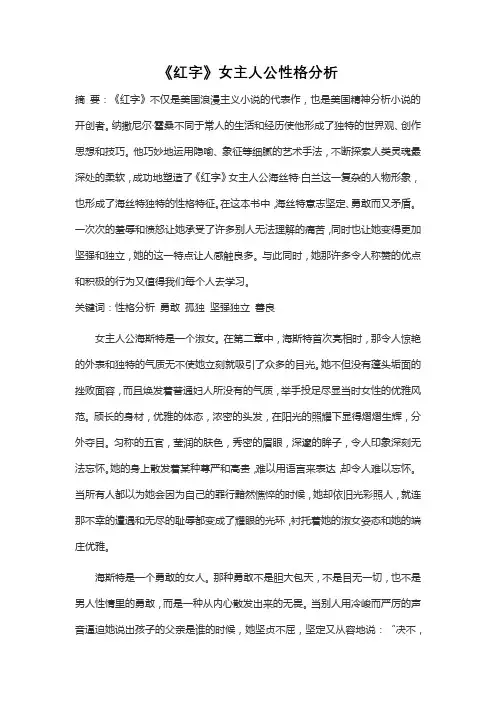
《红字》女主人公性格分析摘要:《红字》不仅是美国浪漫主义小说的代表作,也是美国精神分析小说的开创者。
纳撒尼尔·霍桑不同于常人的生活和经历使他形成了独特的世界观、创作思想和技巧。
他巧妙地运用隐喻、象征等细腻的艺术手法,不断探索人类灵魂最深处的柔软,成功地塑造了《红字》女主人公海丝特·白兰这一复杂的人物形象,也形成了海丝特独特的性格特征。
在这本书中,海丝特意志坚定、勇敢而又矛盾。
一次次的羞辱和愤怒让她承受了许多别人无法理解的痛苦,同时也让她变得更加坚强和独立,她的这一特点让人感触良多。
与此同时,她那许多令人称赞的优点和积极的行为又值得我们每个人去学习。
关键词:性格分析勇敢孤独坚强独立善良女主人公海斯特是一个淑女。
在第二章中,海斯特首次亮相时,那令人惊艳的外表和独特的气质无不使她立刻就吸引了众多的目光。
她不但没有蓬头垢面的挫败面容,而且焕发着普通妇人所没有的气质,举手投足尽显当时女性的优雅风范。
颀长的身材,优雅的体态,浓密的头发,在阳光的照耀下显得熠熠生辉,分外夺目。
匀称的五官,莹润的肤色,秀密的眉眼,深邃的眸子,令人印象深刻无法忘怀。
她的身上散发着某种尊严和高贵,难以用语言来表达,却令人难以忘怀。
当所有人都以为她会因为自己的罪行黯然憔悴的时候,她却依旧光彩照人,就连那不幸的遭遇和无尽的耻辱都变成了耀眼的光环,衬托着她的淑女姿态和她的端庄优雅。
海斯特是一个勇敢的女人。
那种勇敢不是胆大包天,不是目无一切,也不是男人性情里的勇敢,而是一种从内心散发出来的无畏。
当别人用冷峻而严厉的声音逼迫她说出孩子的父亲是谁的时候,她坚贞不屈,坚定又从容地说:“决不,我不会说的!”无论其他人对她怎样好言相劝,或者是威逼恐吓,她都无动于衷,也没有一丝一毫的犹豫,只是保持着自己的坚定和勇敢,心甘情愿地承担所有需要遭受的痛苦。
那种无畏不是强装出来的,也不是别人给予的,是从骨子里透露出来的。
在当时那种时代背景下,倘若不是拥有这样无比的勇敢,海斯特可能一分钟也无法在世间生存。
《红字》女主人公海丝特·白兰个性分析
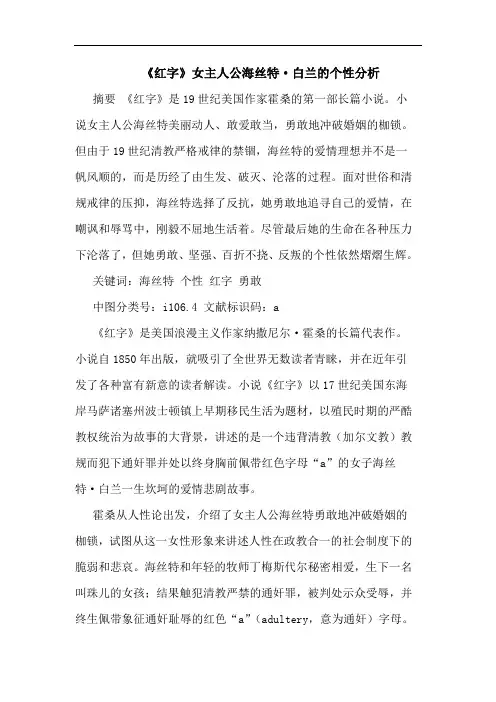
《红字》女主人公海丝特·白兰的个性分析摘要《红字》是19世纪美国作家霍桑的第一部长篇小说。
小说女主人公海丝特美丽动人、敢爱敢当,勇敢地冲破婚姻的枷锁。
但由于19世纪清教严格戒律的禁锢,海丝特的爱情理想并不是一帆风顺的,而是历经了由生发、破灭、沦落的过程。
面对世俗和清规戒律的压抑,海丝特选择了反抗,她勇敢地追寻自己的爱情,在嘲讽和辱骂中,刚毅不屈地生活着。
尽管最后她的生命在各种压力下沦落了,但她勇敢、坚强、百折不挠、反叛的个性依然熠熠生辉。
关键词:海丝特个性红字勇敢中图分类号:i106.4 文献标识码:a《红字》是美国浪漫主义作家纳撒尼尔·霍桑的长篇代表作。
小说自1850年出版,就吸引了全世界无数读者青睐,并在近年引发了各种富有新意的读者解读。
小说《红字》以17世纪美国东海岸马萨诸塞州波士顿镇上早期移民生活为题材,以殖民时期的严酷教权统治为故事的大背景,讲述的是一个违背清教(加尔文教)教规而犯下通奸罪并处以终身胸前佩带红色字母“a”的女子海丝特·白兰一生坎坷的爱情悲剧故事。
霍桑从人性论出发,介绍了女主人公海丝特勇敢地冲破婚姻的枷锁,试图从这一女性形象来讲述人性在政教合一的社会制度下的脆弱和悲哀。
海丝特和年轻的牧师丁梅斯代尔秘密相爱,生下一名叫珠儿的女孩;结果触犯清教严禁的通奸罪,被判处示众受辱,并终生佩带象征通奸耻辱的红色“a”(adultery,意为通奸)字母。
人性与宗教、社会的冲突与摩擦贯彻在小说当中。
《红字》大力颂扬了人性和人类道德行为中的真善美,无情地揭露和鞭笞了人性和人类道德行为中的假恶丑,对残酷地压抑人性的宗教统治进行了批判。
一海丝特·白兰勇敢地追寻爱情爱的力量是自然人与生俱来的,是人类共同的精神产品和情感结晶,而爱情永远是人类生活中最美好的情感之一,是最为重要,最为可贵,最值得推崇的。
《红字》中的女主人公海丝特就是一个为了爱情永不放弃,勇敢追求的人。
女性自由抗争的代表——简论霍桑《红字》中的女主人公海丝特
女
性
自
由 抗
争
的
代
表
简论 霍桑《 字》 红 中的女 主人 公 海丝特
韩冬玲
( 州 师范 高等 专科 学 校 预科 部 , 苏 泰 兴 泰 江
摘 要 :小 说 《 字 》 美 国 浪 漫 主 义 作 家 纳 撒 尼 红 是
250 ) 2 4 0
与 男 子一 样 的 自由平 等权 利 。而 霍桑 也 赞 同十 七世 纪 英
丽 装 扮 显 示 了其 内 心 大 胆 狂 放 的 渴 望 : 敢 于 相 信 自己 . 她 相 信 自 己爱 的权 利 和 力 量 ,认 为 她 与 齐 灵 渥 斯 的 婚 姻 是
“
一
种 错 误 而 不 自然 的 关 系 ” ,是 源自 种 爱 情 的 献 祭 。 她 的
“ 苞 的青 春 ” 乎被 埋 葬在 这 不 合理 的婚 姻 中 。劳伦 斯 含 几 说 过 :如 果 精 神 和 肉 体 不 能 和 谐 ,如 果 它 们 没 有 自然 平 “ 衡 和 自然 的相互 尊 敬 , 么生 命 是难 堪 的 。” 了尽可 能 那 为 避 免 这 种 生 命 的 难 堪 , 得 新 的 生 命 意 义 , 丝 特 挣 脱 了 获 海 清教 教义 的一切 束 缚 , 从 人 类生 命 本性 的呼 唤 。 勇敢 听 她 地 不 顾 一 切 地 爱 上 了 温 文 尔 雅 、一 表 人 才 的 青 年 教 士 丁
自
小 说 《 字 》 S alt etr 1 5 ) 美 国 著 名 浪 红 ( c r L t ,8 0 是 e e 漫 主 义 小 说 家 纳 撒 尼 尔 ・ 桑 ( ta ilHa to e . 霍 Nah ne w h n o 10 — 1 6 ) 代 表 作 , 取 材 于 清 教 主 义 时 期 新 英 格 兰 84 8 4 的 它
《红字》中海斯特的女性意识
浅析《红字》中海斯特的女性意识【摘要】《红字》是19世纪美国作家霍桑的一部著名长篇小说,主要讲述了17世纪新英格兰在北美清教徒殖民统治下的悲惨情况,展现了政教合一的殖民统治对当时女性的迫害。
文章主要分析了女主人公海斯特·普琳女性的意识觉醒。
【关键词】海斯特·普琳《红字》女性意识海斯特·普琳是《红字》中最重要的女主人公,她给读者的第一印象就是叛逆,这种叛逆的性格正体现了她的女性意识。
弗雷德里克·艾·卡彭特教授曾对海斯特这一形象给以了高度评价。
他认为:“《红字》的伟大之处就在于海斯特·普琳这一人物。
”作者站在女性主义的角度分析了海斯特怎样从懵懵懂懂的少女成长为不畏夫权、政权和宗教的压迫成长为一个坚强的女战士、妇女活动家,以及永不放弃追求幸福的思想者。
一绞刑台下的尊严对海斯特通奸罪的惩罚之一就是怀抱婴儿在绞刑台站立三小时。
在17世纪的新英格兰,这一惩罚对犯人来说并非易事。
它不仅要在公众面前暴露自己的丑事,忍受别人的嘲笑和蔑视,而且这一切“在当时笼罩着一种末日般的可怕的庄严”。
然而,海斯特在走出牢门那一刻,并没有像人们所想象的那样变得呆滞和憔悴,她面带微笑,带着优雅和高傲的气质从容不迫地环视着周围的人,勇敢地向众人展示她的孩子,以及代表耻辱的a字,她把a字绣的那么华贵,那么雅致,让人不禁产生想象。
在严酷的绞刑台上海斯特宁死不说出同犯的名字,一人承受着严厉的惩罚。
虽然忍受着内心的煎熬,海斯特却以自己的方式捍卫了尊严,这代表着她的女性意识也在潜滋暗长。
二单身女人的顽强生活——女性意识的萌动海斯特在出狱后的生活是艰难而痛苦的,她在城郊选择了一间小茅屋与女儿相依为命,她靠自己的针线手艺赚取一些收入来养活自己和女儿。
不仅是物质上的匮乏,海斯特承受的最大痛苦是来自于公众对她的蔑视。
在一片陌生的土地上,海斯特没有朋友,没有家人。
贵妇们戏弄她给她难堪,她施舍过的穷人辱骂她,就连小孩子都觉得海斯特非常可怕,经常躲在她后面尖叫。
《红字》中的海斯特白兰人物形象分析 海斯特白兰是怎样的人
《红字》中的海斯特白兰人物形象分析海斯特白兰是怎样的人(最新版)编制人:__________________审核人:__________________审批人:__________________编制单位:__________________编制时间:____年____月____日序言下载提示:该文档是本店铺精心编制而成的,希望大家下载后,能够帮助大家解决实际问题。
文档下载后可定制修改,请根据实际需要进行调整和使用,谢谢!并且,本店铺为大家提供各种类型的经典范文,如诗歌散文、原文赏析、读书笔记、经典名著、古典文学、网络文学、经典语录、童话故事、心得体会、其他范文等等,想了解不同范文格式和写法,敬请关注!Download tips: This document is carefully compiled by this editor.I hope that after you download it, it can help you solve practical problems. The document can be customized and modified after downloading, please adjust and use it according to actual needs, thank you!In addition, this shop provides you with various types of classic sample essays, such as poetry and prose, original text appreciation, reading notes, classic works, classical literature, online literature, classic quotations, fairy tales, experience, other sample essays, etc. if you want to know the difference Please pay attention to the format andwriting of the sample essay!《红字》中的海斯特白兰人物形象分析海斯特白兰是怎样的人【导语】:海斯特白兰是《红字》中的主要人物,关于海斯特白兰是怎样的人一直受到大家的关注,来了解一下吧。
《红字》中的女性主义分析
《红字》中的女性主义分析摘要:本篇论文运用女性主义批评理论与方法探究霍桑在《红字》中所体现的女性主义意识及其进步意义。
通过对女主人公海斯特的性格分析,我们发现霍桑具有进步的女性主义意识,这在他同时代的男作家中是罕见的。
对于海斯特对父权社会不屈服和反叛,霍桑表现出了极大的同情;对于海斯特勇于挑战清教徒的清规戒律,他表现出极大的欣赏。
在小说中,海斯特被描述成一个具有反叛精神和女性主义意识的女子。
她勇敢、坚强、独立、能干又富有爱心,就像一位莅临人间的天使。
她的美德与善行改变了人们对她的敌视态度,赢到了所有人的谅解与尊敬。
正是由于霍桑进步的女性主义意识才使得海斯特的形象刻画非常成功,使得文学史上多了一位光彩照人的独立女性形象。
小说有助于我们更好地了解19世纪妇女的生存状况,她们的困境,她们的不屈斗争,从而唤起人们重视女性的价值。
关键词:霍桑;女权主义意识;海斯特;父权主义社会一、介绍女性主义是社会关注的焦点,它通过历史的进步、女性灵魂的解放、人文主义的真正体现,成为人类文明的象征。
在英美文学中,弗吉尼亚·伍尔夫等一些大师研究了一些女性主义理论来分析女性主义意识,这是英美文学的一个突出亮点。
另一位学者霍桑小说“红字”中也表达他对女权主义的看法。
他为理解人类历史上的女权主义做出了宝贵的贡献。
本文旨在运用一些女性主义批评理论和方法来解读霍桑在“红字”中主人公海丝特的人物塑造中所反映出来的女性主义意识。
在妇女解放运动的影响下,一种被称为女性主义文学批评的批评方法应运而生,并逐渐成为主要的批评方式之一。
二、女性主义理论由于我们要分析“红字”中的女权主义,首先要了解一些关于女性主义理论的知识。
以下是对女性主义批评理论的简要介绍。
女权主义是文学领域的一股春风,揭示了妇女权利的敏感问题,引发了各种女性主义理论。
主要通过女性主义批评家理论与女性主义方法论对女性主义的分析。
女权主义认为妇女应拥有与男子平等的政治、社会、性、智力、就业和经济权利。
- 1、下载文档前请自行甄别文档内容的完整性,平台不提供额外的编辑、内容补充、找答案等附加服务。
- 2、"仅部分预览"的文档,不可在线预览部分如存在完整性等问题,可反馈申请退款(可完整预览的文档不适用该条件!)。
- 3、如文档侵犯您的权益,请联系客服反馈,我们会尽快为您处理(人工客服工作时间:9:00-18:30)。
湖南第一师范学院毕业论文(设计) 题目(中文) 《红字》中女主人公个性分析(英文)An Analysis of the Personality of the Heroine in The Scarlet Letter学生姓名刘文叶学号09404040421指导教师姚芬芳系(部)外语系专业班级09英语4班完成时间2013年5月An Analysis of the Personality of the Heroine inThe Scarlet LetterByLIU WenyeA Thesis Submitted in Partial Fulfillment of the Requirementsfor the Degree ofBACHELOR OF ARTSDepartment of Foreign Language,HUNAN FIRST NORMAL UNIVERSITYMay, 2013毕业论文(设计)作者声明1.本人提交的毕业论文(设计)是本人在指导教师指导下独立进行研究取得的成果。
除文中特别加以标注的地方外,本文不包含其他人或其它机构已经发表或撰写过的成果。
对本文研究做出重要贡献的个人与集体均已在文中明确标明。
2.本人完全了解湖南第一师范学院有关保留、使用学位论文的规定,同意学院保留并向国家有关部门或机构送交本文的复印件和电子版,允许本文被查阅、借阅或编入有关数据库进行检索。
同意湖南第一师范学院可以采用影印、打印或扫描等复制手段保存和汇编本文,可以用不同方式在不同媒体上发表、传播本文的全部或部分内容。
3.湖南第一师范学院在组织专家对毕业论文(设计)进行复审时,如发现本文抄袭,一切后果均由本人承担,与学院和毕业论文指导教师无关。
作者签名:日期: 年月日摘要纳撒尼尔·霍桑是 19 世纪美国著名的小说家,其作品对美国短篇小说的发展起着重要的作用。
《红字》是霍桑著名的代表作之一,也是众多学者研究的对象。
本文试图以《红字》为文本,结合当时的时代背景与女主人公海斯特·白兰的生活环境及个人经历,探索海斯特在不同时期的个性特点。
本文通过对海斯特的个性分析,揭露19世纪资本主义发展时代社会典法的残酷、宗教的欺骗和道德的虚伪。
因为霍桑的小说反映出当时深厚的社会、宗教和哲学背景,所以,即使在新的世纪里其作品仍然值得我们研究和分析。
关键词:霍桑;海斯特;个性;《红字》AbstractNathaniel Hawthorne was one of the famous American novelists in the 19th century, whose works plays an important role in the development of the US short stories. The Scarlet Letter is one of his famous novels and it is studied by many scholars. This article attempts to take it as the text, and unify the historical background of the US in the 19th century and Hester’s life surroundings and personal experience to explore the characteristics of Hester in different times. The article mainly analyzes Hester’s three characteristics and her performance, revealing the cruelty of social rules, deception of religion and hypocrisy of morality in 19th century. Hawthorne's novels reflect their profound social, religious and philosophical background. Even in the new century, they are still worth of studying and analyzing.Key words: Hawthorne; Hester; characters; The Scarlet LetterCONTENTS中文摘要 (I)Abstract (II)Chapter 1 Introduction (1)Chapter 2 The Analysis on Hawthorne and The Scarlet Letter (3)2.1 Hawthorne (3)2.2 The Scarlet Letter (4)Chapter 3 The Analysis on the Background (6)3.1 The Historical Background (6)3.1.1 America in the Roman tic Period (6)3.1.2 Puritanism Influence on America (8)3.2 The Life Background (10)3.2.1 The Surroundings (10)3.2.2 The Individual Experience (11)Chapter 4 The Analysis on Hester’s Character.................................. .144.1 Her Bravery ............................................... .错误!未定义书签。
44.1.1 The Pursuit of Love (14)4.1.2 The Assumer of Her Guilt (15)4.2 Her Rebellion ............................................. 错误!未定义书签。
54.2.1 Her Attitude to Church (16)4.2.2 Her Escape from Reality (17)4.3 Her Compromise (18)4.3.1 Her Struggle in Thought (18)4.3.2 Her Return to Boston (20)Chapter 5 Conclusion (22)Bibliography (23)Acknowledgements (24)Chapter1IntroductionThe novel The Scarlet Letter is a famous masterpiece of Nathaniel Hawthorne, the famous American romantic novelist in the 19th century. The novel is a tragic love story that took place in New England of the 17th century. The heroine Hester Prynne is a kind beautiful English girl and unfortunately marries Roger Chillingworth, a malformed hypocritical old scholar. Later on the way to Boston, Massachusetts, New England, North America, Hester’s husband is captured and never arrives at his destination. In the nearly two years of widowed life, Hester falls in love with Dimmesdale, the local parish priest and gives birth to Pearl, her daughter who is beautiful and full of intelligence. After that, the Puritan regime of the state and the church take her as a specimen of sin, and punish her by taking a red letter “A” in English (ie the first letter of adultery) in her chest and living the whole life humbly. Dimmesdale is not exposed publicly, however, dies of the psychological torture and the persecution of Chillingworth.The Scarlet Letter is a unique, thoughtful and imaginative work, attracting the attention and comments more than a century, which is recognized as the most outstanding representative work of Hawthorne. Hester Prynne, the heroine of The Scarlet Letter, is a quite real and complex female image. Hester has her sins and shortcomings, but she has more admirable strength and virtue. She lives in an isolated and helpless environment, spending a long and painful process of self-transformation. On the one hand, she learns to obey and do good things; on the other hand, she keeps independent and revolted, not to yield to the Puritanregime which oppresses her severely.There are so many scholars starting to study The Scarlet Letter of Nathaniel Hawthorne. Some of them study the environment and skills reflected in the novel, some of them study Puritanism and Feminism, others study the characters in the novel and so on. However, this article attempts to take The Scarlet Letter as the text, and unify the historical background of the US in the 19th century and Hester’s life surroundings and personal experience to explore the characteristics of Hester in different times. The article mainly analyzes Hester’s three characteristics and her performance, revealing the cruelty of social rules, deception of religion and hypocrisy of morality in 19th century. Hawthorne's novel has its profound social, religious and philosophical background. Even in the new century, it is still worth of learning and thinking by us.Chapter2The Analysis on Hawthorne and The Scarlet Letter2.1 HawthorneNathaniel Hawthorne was a famous American novelist and short story writer, who was born on July 4, 1804 in Salem, Massachusetts. His ancestors included John Hathorne, the only judge involved in the Salem witch trials who never repented of his actions. Nathaniel later added a "w" to make his name "Hawthorne" in order to hide this relation. He entered Bowdoin College in 1821, was elected to Phi Beta Kappa in 1824, and graduated in 1825. Hawthorne published his first work, a novel titled Fanshawe, in 1828; he later tried to suppress it, feeling it not equal to the standard of his later work. He published several short stories in various periodicals which he collected in 1837 as Twice-Told Tales. The next year, he became engaged to Sophia Peabody. He worked at a Custom House and joined Brook Farm, a transcendentalist community, before marrying Peabody in 1842. The couple moved to The Old Manse in Concord, Massachusetts, later moved to Salem, the Berkshires, then to The Wayside in Concord. The Scarlet Letter was published in 1850, followed by a succession of other novels. A political appointment took Hawthorne and family to Europe before their return to The Wayside in 1860. Hawthorne died on May 19, 1864, and his wife and their three children survived.Much of Hawthorne's writing centers on New England, many works featuring moral allegories with a Puritan inspiration. His fiction works are considered part of the Romantic Movement, more specifically, Dark romanticism. His themes often center on the inherent evil and sin ofhumanity, and his works often have moral messages and deep psychological complexity. His works include novels, short stories, and a biography of his friend Franklin Pierce.2.2 The Scarlet LetterThe Scarlet Letter is an 1850 romantic work of fiction in a historical setting, written by Nathaniel Hawthorne. It is considered to be his magnum opus. Set in 17th-century Puritan Boston, Massachusetts during the years 1642 to 1649, it tells the story of Hester Prynne, who conceives a daughter through an adulterous affair and struggles to create a new life of regret and dignity. Throughout the book, Hawthorne explores themes of legalism, sin, and guilt.The experience of Hester and Dimmesdale recalls the story of Adam and Eve, because, in both cases, sin results in expulsion and suffering. But it also results in knowledge—specifically, in knowledge of what it means to be immoral. For Hester, the red letter “A”functions as "her passport into regions where other women dar e not tread”, leading her to speculate about her society and herself more boldly than anyone else in New England.Another theme is the extreme legalism of the Puritans and how Hester chooses not to conform to their rules and beliefs. Hester is rejected by the villagers even though she spends her life doing what she can to help the sick and the poor. Because they rejected her, she spends her life mostly in solitude, and will not go to church. As a result, she retreats into her own mind and her own thinking. Her thoughts begin to stretch and go beyond what will be considered by the Puritans as safe or even Christian. She still sees her sin, but begins to look on it differently than the villagers ever have. She begins to believe that a person's earthly sins do not necessarily condemn them. She even goes so far as to tellDimmesdale that their sin has been paid for by their daily penance and that their sin will not keep them from getting to heaven, however, the Puritans believe that such a sin surely condemns. But Hester has been alienated from the Puritan society, both in her physical life and spiritual life. When Dimmesdale dies, she knows she has to move on because she can no longer conform to the Puritans' strictness. Her thinking is free from religious bounds and she has established her own different moral standards and beliefs.Chapter3The Analysis on the Background3.1 The Historical BackgroundAmerica stepped into the romantic period from about 1830 and ended about in 1870, when The Scarlet Letter was completed and published. Although Nathaniel Hawthorne lived in the 19th century, however, the novel described a story in the 17th century, when Puritan played an important role in America history.3.1.1 America in the Romantic PeriodThe American Romantic period, which lasted from 1830 to 1870, was a time of rapid expansion and growth in the United States that fueled intuition, imagination, and individualism in literature. When you think about stories that are labeled “romantic”, you p robably think of a romance novel, where some half-dressed woman has some Fabio-esque guy hanging all over her. That is not what we're talking about in the American Romantic period. Like those stories, Romantic literature is both adventuresome and improbable, but it is a lot more than just a randy love story.In 1830, just fifty years after the Revolutionary War, America was still really young, but its citizens were anxious to create their own identity that was uniquely American and not so reliant on European values. Therefore, the American Romantic movement challenged the very rational thinking in the Age of Reason during the Revolutionary War. This period produced fewer instructional texts and more stories, novels, and poetry.Within these stories, novels, and poems, there are fivecharacteristics that we used to identify American Romantic literature. These are imagination, individuality, nature as a source of spirituality, looking to the past for wisdom, and seeing the common man as a hero.The development of the American society nurtured “the literature of a great nation.” As the nation grew in size and ambition, people began to long for owning their own literature. Many writers made efforts to attract notice abroad, and their books drew attention and praise from important foreign figures. Although English literature models were still admired, the American writers soon turned to the American scene and civilization, and found their materials in the culture and history, the lore and landscape of their native land. Irving, Cooper, Bryant, and Pe all found audiences in foreign lands. Much of the interest was in reading about life in a new, experimental country which appeared remote and exotic to most Europeans. But the American writers were praised by critics as well as by plain readers, and observers saw this recognition as a sign of the maturing of American culture.New England Transcendentalism was a main literacy stream in romantic period and also the summit of American Romanticism. The major features of New England Transcendentalism can be summarized as follows: first, the Transcendentalists placed emphasis on spirit, or the Oversoul, as the most important thing in the universe. Second, the Transcendentalists offered a fresh perception of nature as symbolic of the Spirit or God. New England Transcendentalism inspired a whole new generation of famous authors such as Emerson, Thoreau, Hawthorne, Melville, Whiteman and Dickinson. Without its impetus America might have been deprived of one of its most prolific literary periods in its history.3.1.2 Puritanism Influence on AmericaEarly in the 17th century some Puritan groups separated from the Church of England. Among these were the Pilgrims, who in 1620 founded Plymouth Colony. Ten years later, under the auspices of the Massachusetts Bay Company, the first major Puritan migration to New England took place. The Puritans brought strong religious impulses to bear in all colonies north of Virginia, but New England was their stronghold, and the Congregationalist churches established there were able to perpetuate their viewpoint about a Christian society for more than 200 years.Richard Mather and John Cotton provided clerical leadership in the dominant Puritan colony planted on Massachusetts Bay. Thomas Hooker was an example of those who settled new areas farther west according to traditional Puritan standards. Even though he broke with the authorities of the Massachusetts colony over problems of religious freedom, Roger Williams was also a true Puritan in his zeal for personal godliness and doctrinal correctness. Most of these men held ideas in the mainstream of Calvinistic thought. In addition to believing in the absolute sovereignty of God, the total depravity of man, and the complete dependence of human beings on divine grace for salvation, they stressed the importance of personal religious experience. These Puritans insisted that they, as God's elect, had the duty to direct national affairs according to God's will as revealed in the Bible. This union of church and state to form a holy commonwealth gave Puritanism direct and exclusive control over most colonial activity until commercial and political changes forced them to relinquish it at the end of the 17th century.Because of its diffuse nature, when Puritanism began to decline in America is difficult to say. Some would hold that it lost its influence inNew England by the early 18th century, but Jonathan Edwards and his able disciple Samuel Hopkins revived Puritan thought and kept it alive until 1800. Others would point to the gradual decline in power of Congregationalism, but Presbyterians under the leadership of Jonathan Dickinson and Baptists led by the example of Isaac Backus (1724 - 1806) revitalized Puritan ideals in several denominational forms through the 18th century.During the whole colonial period Puritanism had direct impact on both religious thought and cultural patterns in America. In the 19th century its influence was indirect, but it can still be seen at work stressing the importance of education in religious leadership and demanding that religious motivations be tested by applying them to practical situations.American Puritanism was one of the most enduring shaping influences in American thought and American literature. It has become, to some extent, so much a state of mind, rather than a set of tenets, so much a part of the national cultural atmosphere that the Americans breathe. Without some understanding of Puritanism, there can be no real understanding of American culture and literature.Puritans was the name given in the 16th century to the more extreme Protestants within the Church of England who thought the English Reformation had not gone far enough in reforming the doctrines and structure of the church. They wanted to purify their national church by eliminating every shred of Catholic influence. In the 17th century many Puritans emigrated from the New World, where they sought to found a holy Commonwealth in New England. Puritanism remained the dominant cultural force in that area into the 19th century.Puritans believed that human beings were predestined by God before they were born. Some were God's chosen people while otherswere predestined to be damned to hell. The success of one's work or the prosperity in his calling given by God was the sign of being God's elect. Therefore, everyone must work hard, spend little and invest for more business. Working hard and living a moral life were their ethics. They regarded Bible to be the authority of their doctrine. To be able to read the Bible and understand God's will, education was essential for Puritans. 3.2 The Life BackgroundHester lives in New England, a colony of North America. At that time, Puritans seriously advocate people to believe God. It is an honor to be chosen by God, but others are predestined to be damned to hell. However, Hester is hurt by the Puritanism. The novel reveals the darkness and cruelty of the colonial domination and the hypocrisy and ferocity of the church through reflection of Hester’s miserable sufferings.3.2.1 The SurroundingsPuritans originates from the first thorough religious reform by English King Henry VIII in the 16th century. They want to clear the remnants of the Catholic for purer life. Puritanism generalizes the thoughts and the behavior of Puritan. Puritans begin to emigrate in the end of the 16th century because of the English domestic suppressed policy from 16th to 17th century, and this culminates from 1730s to 1740s. With the self-confidence of God's chosen, the Puritans come to North America to take the mission of the establishment of the New Jerusalem. Their beliefs and practices have a profound impact to the United States of the colonial period, especially northern New England Puritan colonies. They leave a deep imprint in its political, economic and cultural field, and with the economic development of New England, the Puritans’ westward settlements thereby affect the whole American society.Puritan predestination prompts the Puritans to concern both the internal self-cultivation and the external success to please God. Puritan predetermined theory gives God the absolute power, and God chooses some human as the chosen people according to their free will. On the one hand, they have to strive for introspection and high moral standards requirements to make life sanctified and show their voters. On the other hand, they have to please God and deserve God’s chosen by doing the vo cation and obtaining success in vulgar industry. Puritans’ attitude to economy is deeply affected by their view of duty and wealth, so they can accumulate wealth without guilt. Puritanism considers that God gives gift to the voters and judges their behavior through vocation.Puritans must be serious, thrifty, industrious, honest and pious, which plays an important role in the formation of the spirit of capitalism. The diligence makes the Puritans do startling results on the infertile land in New England; earnest and thrift makes Puritans put limited time, energy on the labor for the glory of God and put a lot of wealth on reproduction not for comfort and enjoyment; loyalty and keeping promise promotes the credibility of the capitalism.3.2.2 The Individual ExperienceHester Prynne is the protagonist of Nathaniel Hawthorne's novel The Scarlet Letter. She is portrayed as a woman condemned by her Puritan neighbors. The character has been called "among the first and most important female protagonists in American literature." As a resident of colonial America, Hester is sent ahead to the "New World" by her husband, who later assumes the name of Roger Chillingworth, as he has some business to finish before he can join her. After he is shipwrecked and captured by Native Americans and presumed dead, Hester continues to live her life as a seamstress in the town. She looks to the local pastorArthur Dimmesdale for comfort; somewhere along the way passion emerges, culminating in the conception and subsequent birth of their child, Pearl. Because Hester has no husband with her, she is imprisoned, convicted of the crime of adultery, and sentenced to be forced to wear a prominent scarlet letter “A” for the rest of her life.Though scorned by her fellow citizens, Hester continues to lead a relatively uneventful life. Shortly after the birth of the child and her punishment, Hester's husband reappears and compels her to tell him the name of the child's father. Hester refuses, but swears not to reveal the fact that Chillingworth is her husband to the town folk. Hester continues living her life as a seamstress, providing for herself and her child.Novelist John Updike said of Hester: She is such an arresting and slightly ambiguous figure. She is a funny mix of a truly liberated, defiantly sexual woman, but in the end a woman who accepts the penance that society imposes on her. And I don't know, I suppose she is an epitome of female predicaments. ... She is a mythic version of every woman's attempt to integrate her sexuality with societal demands.One analyst wrote: All the contradictions of Hester Prynne — guilt and honesty, sin and holiness, sex and chastity — make her an enduring heroine of American literature. She is flawed, complex, and above all fertile. The idea of Hester Prynne, the good woman gone bad, is a cultural meme that recurs again and again —perhaps because we as a culture are still trying to figure out who Hester really is and how we feel about her.According to popular tradition, the gravestone of Elizabeth Pain in Boston's King's Chapel Burying Ground was the inspiration for Hester Prynne's grave. Scholar Laurie Rozakis has argued that an alternate or additional source for the story may be Hester Craford, a woman flogged for fornication with John Wedg.In various film adaptations of the novel, Prynne has been portrayed by actresses such as Lillian Gish, Sommer Parker, Meg Foster, Mary Martin, Sybil Thorndike, Senta Berger and Demi Moore. In the cult television Series Twin Peaks the name is also adopted as a pseudonym by the character Audrey Horne. Another literary figure using the surname Prynne is a woman who had an adulterous relation with a pastor in the novel A Month of Sundays by John Updike, part of his trilogy of novels based on characters in The Scarlet Letter. In the musical The Music Man, Harold Hill refers to Hester Prynne in the song "Sadder but Wiser Girl." He sings that he wants a girl with a "touch of sin" remarking "I hope, I pray, for Hester to win just one more A."Chapter4The Analysis on Hester’s Character4.1 Her BraveryThere is no doubt that Hester is a brave woman. Hester falls in love with Dimmesdale, the priest, and conceives a daughter, Pearl. Many people think her as unchaste woman, but Hester admits her mistakes bravely and takes the crime without fear by herself. More valuable is that Hester refuses to speak the priest’s name. She protect s him all the time by this way.4.1.1 The Pursuit of LoveIn isolated days in Boston, Hester becomes acquainted with the young pastor Dimmesdale. The most intense feeling of her heart is awakened, the love between them produced, and this kind of love, however, is impossible in the social system and religious law developing into a legal marriage. In this case, she chooses a brave fight to win the road to happiness. They secretly combine. This combination not only shows the courage of her pursuit of a happy marriage, but also reflects her religious revolt, a challenge to the regime, Cardiff rights and religious rights.The birth of their daughter Pearl reveals the crime of Hester. In order to protect her beloved, Hester refuses to say the name of him and determines to bear all the blame and punishment. When the priest Wilson induces her to say the name of adulterer and promises to get rid of the red letter “A” on her chest, Hester g ives an exact answer: No. The letter is branded too deeply to take it down. I hope I can endure my pain, can endure his pain!She bravely bares all the crime, which indicates to the world: the love of her and the priest is immaculate and she is willing to sacrifice woman's self-esteem for her lover. Extraordinary courage and a strong sense of love prompt her to give birth to the child and bring it up. The critics consider Hester impure and immoral, but at this point, they have to admire the bravery and loftiness of her than those who abandons their own flesh and blood to conceal their crime.4.1.2 The Assumer of Her GuiltHester is firm and persistent, never complains to others, and never begs for others’ mercy and forgiveness. She long s for a normal life and goes after true love. She dares to accept new ideas, showing the most intense rebellious spirit before the religious force in that particular historical circumstance. After being humiliated publicly, she chooses to bear the sufferings of life, never begging for sympathy from others.Although someone prepares to show little mercy to her because of having received her help, Hester just puts her hand on the red letter “A” of her chest to show her rejection. She watches the customs of mankind as well as everything created by priests and legislators from a solitary’s view. She criticizes the ribbon of the pastor, robe of judge, the pillory, the gallows, the family, as well as churches and so on.She has little awe for these things, just like the Indians’ feelings about them. On the contrary, her fate and sufferings make her free.4.2 Her RebellionRebellion is one of obvious character of Hester. She never gives up seeking for true love and never ceases to protect Dimmesdale and Pearl. When the dominator wants to take away Pearl, Hester revolts seriously and shouts that he can not take away her and Pearl i s God’s compensation to her. When she sees Dimmesdale is hurt heart and soul byChillingworth, She encourages him to flee with her without hesitation. 4.2.1 Her Attitude to ChurchIn this novel, Hester’s rebellion given by the author is the converging point of her characters. The first opposition action reflects in the fighting for the custody of the child. The birth of Pearl takes so strong disastrous consequences, but for Hester, the child is the direct result of her crime, and she has to take the disgraceful letter “A”.This is Hest er’s full understanding of the shame letter, and her inner confession of staying in Boston to accept the punishment. Under this thought and the isolated circumstance, Hester stands out. She does not weep in her secluded cabin and not wait for the mercy of fate. After sufferings of seven years, Hester becomes more mature, and the way of her opposition turns from the revolt of inner thought to the revolt of external action.When the rulers attempts to take away Pearl, Hester determines to revolt seriously. She stares at the old Puritan Executive in a fierce expression, and shouts to them: God gives me the child, in order to compensate for what you take away from my hands. You can not take away her! I would rather die! Hester never determines to give up Pearl and finally forces the rulers to abandon the conspiracy.Hester’s second action is the ruthless reveal to her ex-husband, which is a sign of her mature characters. When Chillingworth visits Hester in the prison, She is bearing humiliation and under isolated situation, so Hester promises him that she can not tell anyone about his true identity. This i s Hester’s expedient measure of protecting Pearl and preventing Dimmesdale from harm, or her noble act of self-sacrifice. At the same time, she is not clear Chil lingworth’s motivation and purpose. But when she witnesses Dimmesdale struggling with intense pain and in。
